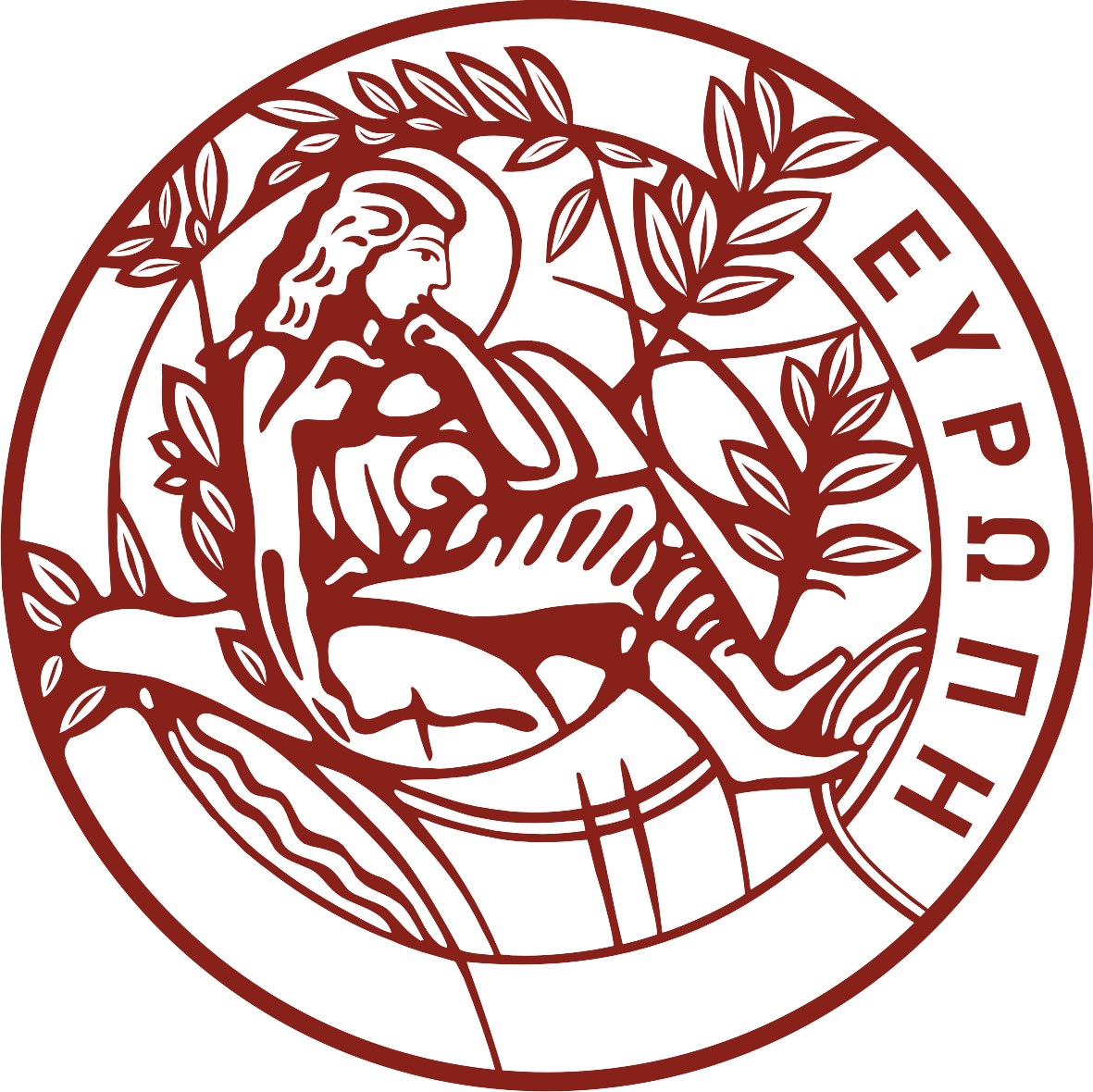Κατάλογος μαθημάτων
A+
A-
| Προσφερόμενα Μεταπτυχιακά Μαθήματα | |||||
|---|---|---|---|---|---|
| Κωδικός | Όνομα Μαθήματος | ECTS(ΔΜ) | Προαπαιτούμενα | Προσφερόμενα | Περιοχές |
| ΗΥ-500 | Εισαγωγή στην Ερευνα | 2 | -- | ||
| ΗΥ-508 | Τεχνική Συγγραφή στα Αγγλικά | 4 | -- | ||
| ΗΥ-523 | Εργαστηριακή Σχεδίαση Ψηφιακών Κυκλωμάτων με Εργαλεία Ηλεκτρονικού Αυτοματισμού | 6 | ΗΥ-220, ΗΥ-225 | A, A1 | |
| ΗΥ-527 | Αρχιτεκτονική Παράλληλων Υπολογιστών | 6 | HY-345, HY-425 | A, A1, A2, Γ | |
| ΗΥ-529 | Προγραμματισμός Πολυπύρηνων Αρχιτεκτονικών | 6 | HY-345, HY425 | A, A2, B1, B2, Γ | |
| HY-531 | Θέματα Θεωρίας Πληροφοριών | 6 | Δεν υπάρχουν προαπαιτούμενα για αυτό το μάθημα | B, B2, B4 | |
| ΗΥ-533 | Εισαγωγή στην Ερευνα στα Δίκτυα Υπολογιστών | 6 | HY-335 | A3, A4, B | |
| ΗΥ-534 | Αρχιτεκτονική Μεταγωγέων Πακέτων | 6 | HY-225, HY-335 | A, A1, A4, B | |
| HY-539 | Προχωρημένα Θέματα σε Ασύρματα Δίκτυα και Κινητά Υπολογιστικά Συστήματα | 6 | HY-335, HY-345 | A4, B, Γ | |
| HY-540 | Προχωρημένα θέματα Ανάπτυξης Γλωσσών Προγραμματισμού | 6 | ΗΥ-340 | B1, B3, Z, Δ | |
| ΗΥ-541 | Ασύρματα Δίκτυα Αισθητήρων | 6 | ΗΥ-335, HY-215 | B, C1, Θ | |
| ΗΥ-543 | Συστήματα Λογισμικού και Τεχνολογίες για εφαρμογές Μεγάλου Ογκου Δεδομένων | 6 | ΗΥ-360, ΗΥ-252, ή άδεια από τον διδάσκοντα | B2, B4, Γ, Δ | |
| ΗΥ-546 | Τύποι και Γλώσσες Προγραμματισμού | 6 | ΗΥ-255, ΗΥ-280 | A2, B1, B3, Z, Γ, Δ | |
| ΗΥ-548 | Αρχιτεκτονικές Λογισμικού για το Υπολογιστικό Νέφος | 6 | ΗΥ-335, ΗΥ-345 | A2, Γ | |
| ΗΥ-553 | Διαδραστικά Γραφικά Υπολογιστών | 6 | ΗΥ-358 ή άδεια του διδάσκοντα | C3, E, Δ, Θ | |
| ΗΥ-558 | Τεχνολογίες και Συστήματα για το Διαδίκτυο | 6 | HY-345 | A3, A4, B, Γ, Δ | |
| HY-559 | Τεχνολογίες Υποδομών για Υπηρεσιοκεντρικά Συστήματα Μεγάλης Κλίμακας | 6 | ΗΥ-345, ΗΥ-360 | A2, A3, B2, H, Γ, Δ | |
| ΗΥ-561 | Διαχείριση Δεδομένων στον Παγκόσμιο Ιστό | 6 | ΗΥ-460 | B2, C3, Δ | |
| HY-562 | Προχωρημένα Θέματα Βάσεων Δεδομένων | 6 | HY-360 | B2, Δ | |
| ΗΥ-563 | Προχωρημένα Θέματα Ανάκτησης Πληροφοριών | 6 | HY-463 | B2, B4, Δ | |
| ΗΥ-565 | Συστήματα Διαχείρισης Διεργασιών | 6 | ΗΥ-360 | ΗΥ-460 | A3, A4, B1, H, Δ, Θ |
| ΗΥ-567 | Αναπαράσταση Γνώσης και Συλλογιστική | 6 | ΗΥ-380, ΗΥ-387 | B2, B4, Δ, Θ | |
| ΗΥ-569 | Συμπόρευση Ανθρώπου – Υπολογιστή | 6 | ΗΥ-364 | ΗΥ-359, ΗΥ-469 | C3, H, Δ, Θ |
| HY-570 | Στατιστική Επεξεργασία Σημάτων | 6 | HY-370, HY-217 | B, B4, C1, C2, E, Θ | |
| ΗΥ-573 | Μέθοδοι Βελτιστοποίησης | 6 | ΗΥ-110, HY-119 | B4, C2, E, Z | |
| HY-575 | Εργαστήριο Ρομποτικής Πλοήγησης | 6 | HY-475 | C2, E | |
| HY-577 | Μηχανική Μάθηση | 6 | HY-150, HY-217, HY-380 | B4, C1, C2, C4, E, H, Z, Δ | |
| HY-578 | Επεξεργασία Φωνής | 6 | HY-370 | B, C1, Θ | |
| HY-580 | Θέματα Σχεδίασης Αλγορίθμων | 6 | HY-240, HY-280, HY-380 | B1, C4, Z | |
| HY-583 | Αλγόριθμοι Γράφων | 6 | HY-240, HY-380 | B1, C4, Z | |
| HY-586 | Κατανεμημένος Υπολογισμός | 6 | ΗΥ-380 | A3, B1, Z, Γ | |
| ΗΥ-587 | Νευρωνικά Δίκτυα και Μάθηση Ιεραρχικών Αναπαραστάσεων | 6 | HY-217, HY-119 ή Μ-105 | B4, C1, C2, C4, Z | |
| ΗΥ-588 | Ανάλυση και Μοντελοποίηση Δικτύων του Εγκεφάλου | 6 | ΗΥ-217, ΗΥ-215, ΗΥ-240 | B, B4, C4, H | |
| ΗΥ-590.31 | Διαδίκτυο των Αντικειμένων για την Έξυπνη Πόλη | 6 | ΗΥ-335, ΗΥ-150 | A4, B, B2, Δ | |
| ΗΥ-590.45 | Σύγχρονα Θέματα Κλιμακώσιμων Συστημάτων Αποθήκευσης | 6 | HY-345, HY-360 | A3, B2, Γ | |
| ΗΥ-590.72 | Introduction to Bioinformatics for Computer Scientists | 3 | Basic knowledge in the areas of theoretical computer science (algorithms, data structures) and technical computer science (sequential optimization in C or C++, computer architectures, parallel programming, vector processors) is required. | C4, H | |
| ΗΥ-590.73 | Seminar in Reproducibility in Bioinformatics | 3 | ΗΥ-590.72 | C4, H | |
| ΗΥ-647 | Σύγχρονα Θέματα Αποθήκευσης Δεδομένων | 6 | ΗΥ-345 | A2, B2, Γ | |
| HY-672 | Προχωρημένα Θέματα Υπολογιστικής Όρασης | 6 | HY-472 | B4, C2, C3, E | |
| ΗΥ-673 | Εισαγωγή στην Γέννηση Δεδομένων με Βαθιά Μάθηση | 6 | ΗΥ-217, ΗΥ-119 | B4, C2, E, Z, Θ | |
| ΗΥ-690.1-4 | Ασκηση και Απόκτηση Θεματικής Εμπειρίας | 3 | -- | ||
| ΗΥ-693 | Εισαγωγή στη Θεωρία Παιγνίων | 6 | B, B1, B4, Z | ||
| ΗΥ-695 | Εποπτευόμενη Μελέτη και Αναφορά | 3 | -- | ||
| ΗΥ-697 | Βιβλιογραφική Ερευνα | 15 | |||
| ΗΥ-698 | Αποτίμηση Ερευνητικής Κατεύθυνσης και Εκπόνηση Ερευνητικού Σχεδίου | 15 | |||
| ΗΥ-699 | Εκπόνηση και Συγγραφή Μεταπτυχιακής Εργασίας | 30 | |||
| ΗΥ-700 | Σεμιναριακά Μαθήματα | 3 | -- | ||



 Ανακοινώσεις
|
Νέα
Ανακοινώσεις
|
Νέα

